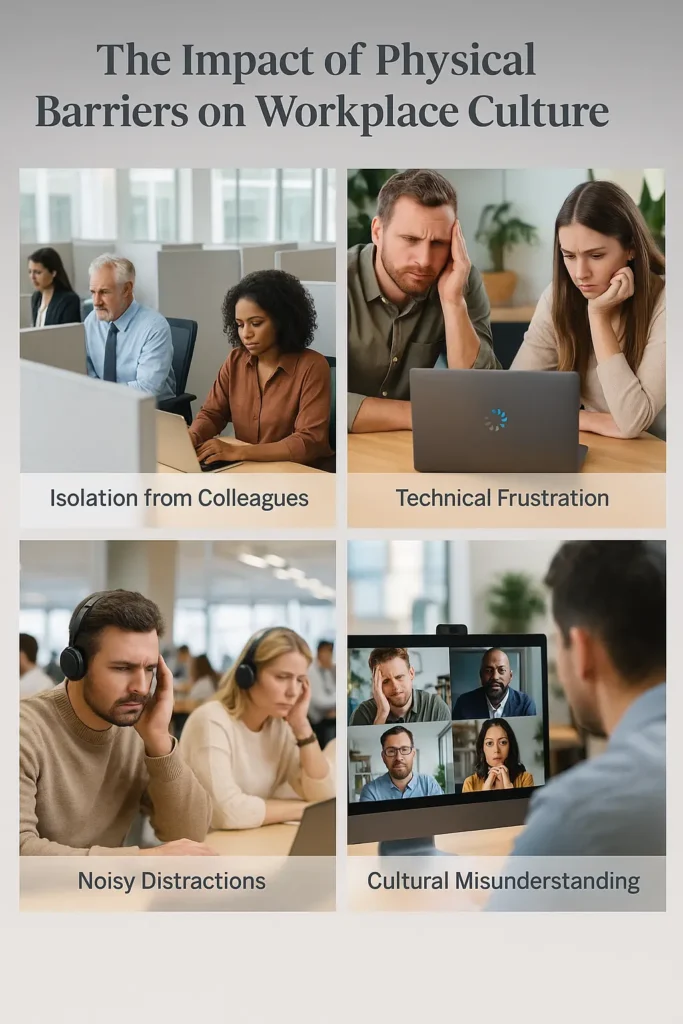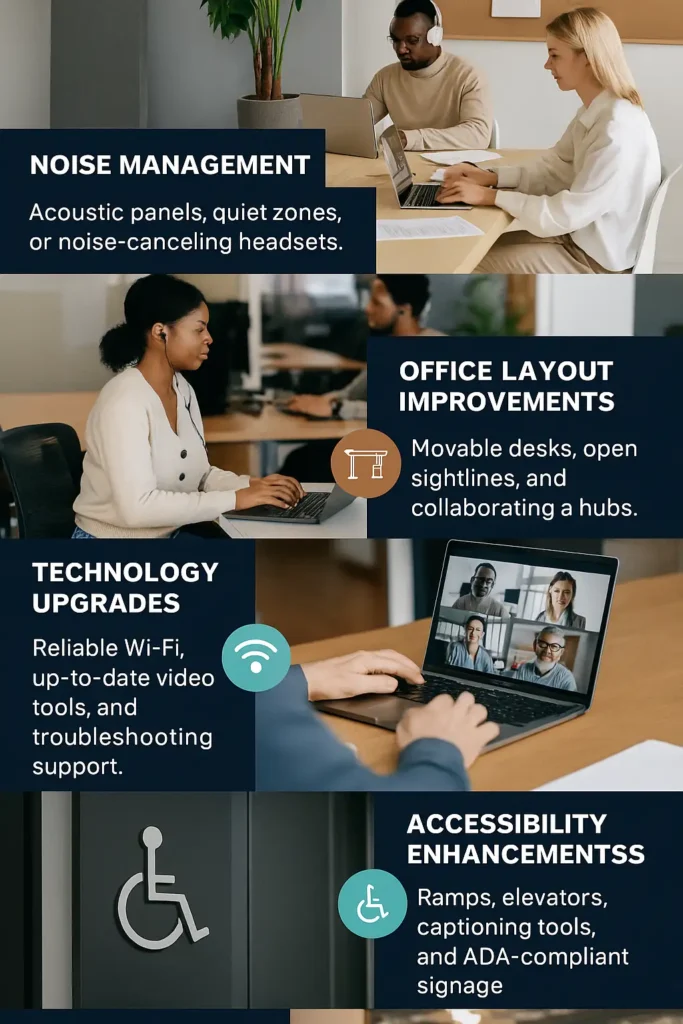Physical Barrier To Communication
Effective communication is essential for teamwork, productivity, and organizational success. However, communication often fails not because of poor intentions or unclear language—but because of physical barriers that interfere with how messages are sent, received, or understood.
Physical barriers to communication are common in modern workplaces, especially with open offices, remote work, and technology-heavy collaboration. Understanding these barriers makes it easier to identify them early and reduce misunderstandings before they disrupt workflow.
What Is a Physical Barrier to Communication?
Physical barriers to communication are tangible or environmental factors that interfere with the effective exchange of information between people.
These barriers can:
- Prevent a message from reaching the receiver
- Distort how the message is heard or seen
- Cause the receiver to misunderstand the sender’s intent
Physical barriers may arise from natural conditions (such as weather or noise) or human-made factors (such as office design, technology, or distance).
In workplace settings, physical barriers directly affect communication efficiency, collaboration, and employee productivity.
Common Physical Barriers to Communication in the Workplace
Below are the most important physical barriers, explained clearly with workplace examples and solutions.
Noise
Noise is one of the most common physical barriers to communication. It includes any sound that interferes with listening or understanding a message.
Workplace examples
- Office chatter or ringing phones
- Construction or traffic outside the building
- Background noise during virtual meetings
- Faulty equipment producing constant humming
Noise can also affect written communication, such as poorly structured emails or unclear documents that distract or confuse the reader.
How to reduce noise barriers
- Hold conversations in quiet areas
- Use noise-canceling headsets
- Fix malfunctioning equipment
- Keep written messages clear and concise

Message Distortion
Message distortion occurs when the receiver interprets a message differently from what the sender intended.
This can happen due to:
- Missing details
- Poor wording
- Inappropriate communication channels
- Technical disruptions
For example, a short email may sound urgent or negative when no such tone was intended.
How to reduce distortion
- Proofread messages before sending
- Choose the right communication medium
- Ask for clarification instead of assuming
- Confirm understanding after important discussions
Office Layout and Architecture
The physical design of a workplace strongly influences communication.
Architectural barriers include
- Large distances between departments
- Closed doors or isolated offices
- Lack of shared meeting or break spaces
- High cubicle walls blocking visibility
Poor layout reduces spontaneous interaction and makes collaboration harder, even when employees rely heavily on emails or calls.
Solutions
- Use open or semi-open layouts where appropriate
- Create shared collaboration spaces
- Encourage open-door policies
- Design offices based on communication needs
Technical Difficulties
Modern workplace communication relies heavily on technology. When tools fail, communication breaks down.
Examples
- Unstable internet connections
- Frozen video calls
- Poor audio quality
- Software glitches
Technical issues delay workflows and increase frustration, especially in remote and hybrid teams.
Solutions
- Test equipment before meetings
- Keep software updated
- Provide technical support
- Use backup communication methods
Time Differences
Time can act as a physical barrier, especially for teams working in different locations.
Examples
- Time zone differences
- Delayed responses to urgent messages
- Missed meetings due to scheduling confusion
Solutions
- Clearly mention time zones in schedules
- Use shared calendars
- Record meetings for later viewing
- Establish overlapping working hours
Physical Distance
Physical distance reduces face-to-face interaction and limits access to nonverbal cues like body language and facial expressions.
This is common among:
- Remote employees
- Hybrid teams
- Multi-location organizations
Solutions
- Use video calls instead of audio-only calls
- Encourage regular virtual check-ins
- Use written follow-ups to confirm details
Information Overload
Too much information can act as a physical barrier by overwhelming the receiver’s attention.
Examples
- Long emails with unnecessary details
- Multiple messages sent at once
- Too many communication channels
Solutions
- Prioritize key points
- Use bullet points and summaries
- Break information into smaller segments
- Avoid unnecessary repetition
Environmental Conditions
Natural environmental factors can also block communication.
Examples
- Thunderstorms or heavy rain disrupting conversations
- Power outages affecting digital communication
- Extreme heat or cold causing discomfort and safety risks
While these conditions are often unavoidable, organizations can prepare in advance.
Solutions
- Create emergency communication plans
- Use alternative communication channels
- Establish clear safety protocols
Additional Physical Barriers Often Overlooked
Accessibility Barriers
Lack of ramps, captions, hearing loops, or readable signage prevents full participation for employees with disabilities. Compliance with ADA and WCAG standards is essential.
Ergonomic Barriers
Uncomfortable chairs, poor desk height, or improper screen placement cause fatigue, reducing focus and listening ability.
Effects of Physical Barriers to Communication
Physical barriers can lead to:
- Reduced productivity
- Misunderstandings and errors
- Increased stress and frustration
- Lower employee morale
- Poor collaboration
- Safety risks during emergencies
Research from the American Psychological Association (APA) links prolonged environmental stressors—such as noise and discomfort—to burnout and disengagement.
Solutions to Overcome a Physical Barrier to Communication

Quick Fixes
- Reduce background noise
- Improve lighting and visibility
- Enable captions in virtual meetings
- Keep messages short and clear
Long-Term Solutions
- Redesign workspaces for collaboration
- Invest in reliable technology
- Improve accessibility and ergonomics
- Conduct regular communication audits
Leadership’s Role
Leaders play a key role in reducing physical barriers by:
- Encouraging open communication
- Investing in accessible environments
- Listening to employee feedback
- Adapting communication practices as work evolves
Conclusion
Physical barriers to communication are common, visible, and manageable. Noise, distance, technology failures, poor layouts, and environmental conditions can silently disrupt workplace communication if left unaddressed.
By recognizing these barriers early and applying practical solutions, organizations can improve clarity, collaboration, and employee satisfaction. Clear communication begins with removing the physical obstacles that stand in the way.



